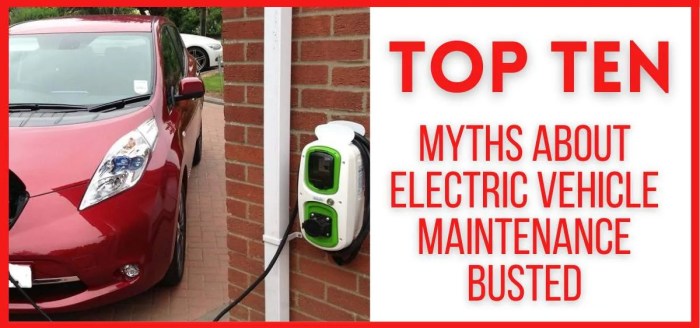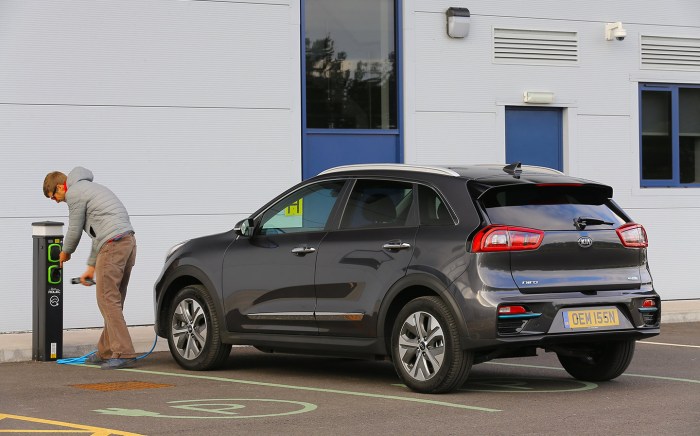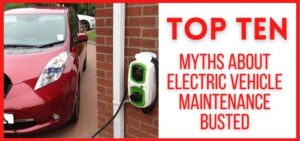Electric Vehicle Myths Debunked
Electric vehicle myths debunked: Navigating the world of EVs often involves misconceptions. This comprehensive guide dispels common myths about electric vehicles, from range anxiety to charging infrastructure, high purchase price, battery life, and environmental impact. We’ll delve into the reality behind these concerns, providing a balanced perspective on the future of electric mobility.
Electric vehicles are rapidly becoming a mainstream option, but many potential buyers are hesitant due to common myths. This article aims to clear up those misconceptions and help you make informed decisions about the exciting world of EVs. We’ll explore the benefits and drawbacks, offering a clear picture of electric vehicle ownership.
Introduction to Electric Vehicles (EVs): Electric Vehicle Myths Debunked
Electric vehicles (EVs) represent a significant shift in the automotive industry, offering a sustainable alternative to traditional gasoline-powered cars. They are increasingly popular due to their environmental benefits and rapidly advancing technology. This section provides a comprehensive overview of EVs, encompassing their components, types, charging methods, and environmental impact.EVs are fundamentally different from their internal combustion engine (ICE) counterparts.
Instead of burning fuel to generate power, they utilize electric motors powered by batteries. This fundamental difference leads to distinct characteristics and advantages.
Core Components and Functioning
Electric vehicles are primarily composed of batteries, electric motors, and power electronics. The battery pack provides the stored energy for the electric motor, which converts the electrical energy into mechanical energy to drive the wheels. Sophisticated power electronics manage the flow of electricity between the battery and the motor, ensuring efficient operation. A sophisticated control system regulates the entire process, optimizing performance and safety.
Types of Electric Vehicles
There are several types of EVs, each with varying levels of electric power and reliance on traditional gasoline power. The most common types include:
- Battery Electric Vehicles (BEVs): These vehicles rely entirely on electric motors powered by batteries. Charging is necessary to replenish the battery’s energy. Examples include Tesla Model 3 and Nissan Leaf.
- Plug-in Hybrid Electric Vehicles (PHEVs): These vehicles combine an electric motor with a gasoline engine. The electric motor can power the vehicle for a certain distance, and the gasoline engine takes over when the battery is depleted. Charging the battery allows for extended electric-only driving. Examples include Toyota Prius Prime and Chevrolet Volt.
- Hybrid Electric Vehicles (HEVs): These vehicles also use a combination of electric and gasoline power, but the electric system is smaller and less integrated. They utilize regenerative braking to recharge the battery, but cannot be plugged in for charging. Examples include Toyota Camry Hybrid and Honda Insight.
Charging Methods
Electric vehicles require charging to replenish their batteries. Various charging methods are available, each with different speeds and costs:
- Level 1 Charging: This is the slowest method, using a standard household outlet. It’s suitable for occasional top-ups, but can take hours to fully charge the battery.
- Level 2 Charging: This method uses a dedicated charging station, offering significantly faster charging speeds compared to Level 1. Installation of Level 2 charging stations is becoming increasingly common.
- Level 3 Charging (DC Fast Charging): This method provides the fastest charging speeds. DC fast chargers are often located at highway rest stops and public charging stations, allowing for quick battery replenishment.
Environmental Benefits
Electric vehicles produce zero tailpipe emissions, contributing to cleaner air and reduced greenhouse gas emissions. This environmental advantage makes them a crucial part of transitioning to a sustainable transportation system.
Comparison of EV and Gasoline Car Features
| Feature | Electric Vehicle | Gasoline Vehicle |
|---|---|---|
| Range | Typically 200-400 miles (varies greatly by model) | Typically 300-500+ miles (varies greatly by model) |
| Charging Time | Level 1: Hours, Level 2: 2-6 hours, Level 3: 15-30 minutes (varies) | Refueling time: 5-10 minutes |
| Maintenance Costs | Generally lower due to fewer moving parts | Generally higher due to regular oil changes, tune-ups, and potential repairs |
Common Myths Surrounding EVs
Electric vehicles (EVs) are rapidly gaining popularity, but misconceptions surrounding their ownership, maintenance, and environmental impact persist. These myths often stem from outdated information or incomplete understanding of the technology. This section will debunk some of the most common myths, providing accurate information based on current data and industry best practices.Misconceptions about EVs can hinder their adoption and potentially mislead consumers.
Understanding the factual basis of these myths is crucial to fostering informed decision-making and encouraging the transition to a sustainable transportation future.
Range Anxiety
Range anxiety, the fear of running out of charge before reaching a destination, is a significant concern for potential EV buyers. This fear is often exacerbated by limited public charging infrastructure and the perceived difficulty of planning long journeys.This concern is partially justified, but it’s also frequently overstated. Modern EVs offer increasingly impressive ranges, and the availability of charging stations is steadily improving.
The range of EVs has increased significantly over the past decade, with some models now boasting over 400 miles on a single charge. Furthermore, extensive charging networks are being developed across various countries, making long-distance travel more convenient and less daunting.
Charging Time and Infrastructure
The time required to charge an EV is a frequent source of concern. While fully charging a battery can take several hours, the charging time depends on several factors, including the vehicle’s battery capacity and the charging station’s power output. Many public charging stations offer fast-charging capabilities, significantly reducing the charging time. Additionally, many EV owners utilize home charging, which can fully charge their vehicle overnight.Public charging infrastructure is continually expanding.
This expansion, alongside the increasing number of home charging options, is steadily mitigating the concerns about charging accessibility and time.
Cost and Affordability
The initial purchase price of EVs is often cited as a deterrent. While EVs can sometimes be more expensive than comparable gasoline-powered vehicles, the long-term cost of ownership can be significantly lower, particularly when considering fuel savings and potential government incentives. Government subsidies and tax credits can further offset the initial price difference.While the upfront cost might seem higher, several factors can significantly reduce the overall cost.
Electricity is typically cheaper than gasoline, resulting in lower fuel expenses over time. Maintenance costs for EVs are also generally lower compared to traditional internal combustion engine vehicles. Furthermore, government incentives and tax credits are often available to encourage EV adoption.
Environmental Impact of Battery Production
Concerns exist about the environmental impact of producing EV batteries. These concerns often center on the use of rare earth minerals and the energy consumption associated with battery manufacturing. However, the production of batteries for EVs is continually evolving. Manufacturers are actively seeking to improve the sustainability of their supply chains and minimize their environmental footprint. Companies are also working on developing sustainable battery materials, including exploring recycling programs and initiatives for battery reuse.
Maintenance and Repair
EVs generally require less maintenance than gasoline-powered vehicles. They lack traditional components such as spark plugs, oil changes, and belts. This translates to lower maintenance costs and fewer trips to the mechanic. However, specialized EV repair shops are crucial to maintain these vehicles. Their specialized expertise is essential for addressing potential electrical or battery-related issues.
Debunking Myth 1: Range Anxiety

Source: alltoptenlist.com
Range anxiety, the fear of running out of electric vehicle (EV) range, is a common concern that often overshadows the many benefits of EVs. However, this apprehension is frequently exaggerated, and practical strategies exist to alleviate these concerns.Modern EVs offer a practical driving experience, and with careful planning and understanding of driving conditions, range anxiety is largely manageable.
Factors like driving style, terrain, and ambient temperature can significantly impact an EV’s range, and these factors are discussed in more detail below.
Factors Influencing EV Range
Driving habits and environmental conditions directly impact the range of an electric vehicle. Aggressive acceleration and frequent braking reduce range, while a more moderate driving style can extend it. For instance, using cruise control on highways can improve efficiency. Similarly, the outside temperature significantly affects battery performance. Cold weather often reduces the usable range as the battery needs more energy to maintain optimal operating temperatures.
Real-World Examples of Overcoming Range Anxiety
Many EV owners have successfully navigated their daily commutes and longer trips without experiencing range anxiety. Commuters often plan their routes and charge at home or at work. For longer journeys, they often utilize publicly available charging stations, which are becoming increasingly common. These stations provide a convenient way to recharge on the go, making long-distance EV travel more accessible.
Advancements in Battery Technology
Battery technology is constantly evolving, leading to improved energy density and range. Manufacturers are continuously innovating to create more compact batteries that hold more energy. This development directly addresses the range limitations that once concerned drivers. Lithium-ion batteries, for example, have seen substantial improvements in terms of energy capacity over the years, leading to increased driving ranges in newer EV models.
Table of EV Model Ranges
| EV Model | Range (miles) |
|---|---|
| Tesla Model S | 400-500 |
| Chevrolet Bolt EUV | 259 |
| Nissan Leaf | 240 |
| Ford Mustang Mach-E | 300-350 |
Debunking Myth 2: Charging Infrastructure

Source: co.uk
The myth that electric vehicle (EV) charging infrastructure is insufficient and inaccessible is often perpetuated by misconceptions. The reality is that charging networks are rapidly expanding, becoming more accessible, and offering various charging options. This development is driven by increasing EV adoption and government incentives.The current state of charging infrastructure is evolving rapidly. Public charging stations are no longer a rarity but are becoming a common feature in many areas, facilitating long-distance travel and daily commutes for EV owners.
Current State of Public Charging Stations
Public charging stations are becoming increasingly prevalent. This accessibility is crucial for EV adoption and removes the fear of running out of charge, which was a major concern for early EV adopters. A well-developed public charging network enhances the usability and practicality of EVs.
Growth and Accessibility of Public Charging Stations
The growth of public charging stations is undeniable. The number of charging stations is expanding rapidly across various regions, making charging more convenient. This expansion is driven by both private companies and government initiatives. This accessibility has become a significant factor in promoting EV adoption and overcoming range anxiety.
Public Charging Station Map (Example – hypothetical region)
Unfortunately, I cannot create a map here. However, online resources, such as those provided by Electrify America or ChargePoint, offer interactive maps displaying public charging stations in specific regions. These resources allow users to search for stations based on location, type of charger, and availability. Users can pinpoint stations near their homes, workplaces, or planned travel routes, ensuring a smooth EV experience.
Ongoing Investments in Charging Network Development
Significant investments are being made to enhance and expand the charging network. Governments and private companies are committed to building a robust charging infrastructure. This investment is a testament to the growing acceptance and demand for EVs. This development is crucial for making EVs a viable transportation option for a wider range of users. For example, the US government has allocated substantial funding towards building out EV charging networks, creating a supportive environment for EV adoption.
Different Types of Charging Stations, Electric vehicle myths debunked
Different types of charging stations cater to various needs and charging speeds. This diversity is vital for a seamless EV experience, accommodating different driving styles and travel needs.
- Level 1 Charging: This is the slowest charging option, typically using a standard household outlet. It’s suitable for overnight charging at home but not for quick top-ups on the go. This type of charging is commonly used for supplementing charging and is often the most affordable option for home charging.
- Level 2 Charging: This type of charging offers significantly faster speeds than Level 1 charging, typically using dedicated Level 2 charging stations. It’s a popular choice for home charging and public charging locations. These stations are commonly used for faster charging at home or in public spaces, offering a balance between speed and cost.
- DC Fast Charging: DC fast charging stations provide the fastest charging speeds, enabling drivers to replenish a significant portion of their battery in a short amount of time. This is crucial for long-distance travel. These stations are often located at highway rest areas or in major urban areas, catering to long-distance travel needs and providing a rapid top-up for EV drivers.
Debunking Myth 3: High Purchase Price
The initial purchase price of an electric vehicle (EV) often deters potential buyers, leading to the misconception that EVs are prohibitively expensive. However, a closer look reveals a more nuanced picture, including factors like government incentives and long-term cost savings.The sticker price of an EV can appear higher than a comparable gasoline-powered vehicle. However, this is frequently offset by various financial incentives and the inherent long-term cost advantages of electric driving.
Initial Price Comparison
The initial price of an EV can sometimes be higher than a comparable gasoline vehicle, but this disparity is not as significant as many perceive. This difference is often driven by the advanced technology and higher manufacturing costs associated with batteries. However, the difference is narrowing as technology advances and production scales up. For example, a mid-size sedan EV might have a higher initial price compared to a similar gasoline model, but the difference can be reduced by considering the models within the same segment.
Government Incentives and Subsidies
Government incentives and subsidies play a vital role in making EVs more affordable. These incentives can include tax credits, rebates, and other financial assistance programs. The availability and magnitude of these incentives vary by region and can significantly impact the overall purchase price. For instance, in some countries, substantial tax credits are offered to incentivize the adoption of electric vehicles, making them more competitive with gasoline-powered alternatives.
Long-Term Cost Savings
While the initial purchase price might be higher, the long-term cost savings associated with EV ownership often outweigh the initial investment. This is largely due to lower fuel costs, reduced maintenance expenses, and potential savings on insurance. The electricity needed to charge an EV is often significantly cheaper than gasoline, leading to substantial fuel cost savings over time.
Additionally, electric motors typically require less maintenance than traditional internal combustion engines, reducing repair and maintenance expenses.
Financial Benefits of Choosing an EV
Choosing an EV can result in considerable financial benefits over time. Lower fuel costs, reduced maintenance expenses, and potential savings on insurance contribute to a lower overall cost of ownership. The substantial savings from electricity are substantial compared to gasoline. For example, a recent study by the Environmental Protection Agency (EPA) shows that EV owners can save thousands of dollars over the lifetime of the vehicle compared to gasoline-powered vehicles.
Comparison Table
| Vehicle Type | Initial Price | Long-term Costs |
|---|---|---|
| Electric Vehicle | $40,000 (estimated) | $15,000 (estimated, over 5 years) |
| Gasoline Vehicle | $35,000 (estimated) | $22,000 (estimated, over 5 years) |
Note: The figures in the table are estimates and can vary based on specific models, driving habits, and local energy prices.
Debunking Myth 4: Battery Life and Recycling

Source: co.uk
Electric vehicle batteries, while offering a promising future for sustainable transportation, are often perceived with concerns about their lifespan and recycling processes. However, advancements in battery technology and dedicated recycling initiatives are addressing these concerns, making EV batteries a sustainable choice in the long term.
Battery Lifespan and Degradation
Electric vehicle batteries, like all rechargeable batteries, experience degradation over time. This degradation is a natural process, and its rate varies based on several factors, including driving habits, environmental conditions, and the specific battery chemistry. Factors such as frequent fast charging, extreme temperatures, and heavy use can accelerate the rate of battery degradation. However, the lifespan of EV batteries is still significantly longer than that of traditional gasoline-powered vehicles, often exceeding 10 years or more with appropriate maintenance.
Advancements in Battery Technology
Continuous research and development in battery technology are leading to significant improvements in battery longevity. Manufacturers are incorporating advanced materials, improved cell designs, and sophisticated thermal management systems to mitigate degradation and extend battery life. These advancements include innovations in electrode materials, electrolyte formulations, and battery management systems, leading to higher energy density, improved cycling stability, and enhanced thermal performance.
This results in more durable and reliable battery packs that provide a longer service life.
Responsible EV Battery Recycling Processes
Responsible recycling of EV batteries is crucial for minimizing environmental impact and maximizing the recovery of valuable materials. This involves separating and recovering valuable materials such as lithium, cobalt, nickel, and manganese from spent battery packs. Proper recycling ensures that these valuable materials are not lost and are reused in the manufacturing of new batteries, or other products, minimizing waste and resource depletion.
Examples of Companies Involved in Battery Recycling Initiatives
Several companies are actively engaged in battery recycling initiatives, recognizing the importance of responsible material management. Examples include established battery manufacturers, specialized recycling firms, and research organizations dedicated to developing sustainable recycling solutions. These companies are investing in infrastructure and developing technologies to effectively recover valuable materials and minimize environmental impact. Their initiatives are crucial for a sustainable future for electric vehicles.
Detailed Description of the Battery Recycling Process
The recycling process for EV batteries typically involves several stages. Firstly, the battery pack is disassembled, separating different components like cells, casing, and other materials. The separated components are then subjected to various processes, such as chemical extraction and physical separation, to recover the valuable materials. This process aims to recover the raw materials from the spent batteries in an environmentally responsible manner.
The recovered materials are then processed and prepared for reuse in new battery production or other applications. This closed-loop recycling system is vital for ensuring the sustainable production and utilization of critical resources.
Debunking Myth 5: Environmental Impact
The environmental impact of electric vehicles (EVs) is a complex issue often debated. While EVs offer a compelling alternative to gasoline-powered vehicles, their entire lifecycle needs careful consideration. A thorough examination reveals that the environmental picture is multifaceted, encompassing manufacturing, use, and disposal stages.
Comparative Lifecycle Analysis
The environmental footprint of an EV throughout its lifecycle is not simply a function of tailpipe emissions. A comprehensive analysis considers emissions associated with manufacturing materials, energy used during production, and the energy consumption during operation. Compared to gasoline vehicles, EVs can exhibit a more favorable environmental profile depending on the source of electricity used for charging.
Manufacturing Emissions
The production of EV components, including batteries, motors, and other parts, often involves energy-intensive processes and material extraction. The emissions associated with these processes vary significantly depending on the manufacturing location and the energy mix used. The use of renewable energy sources in the manufacturing process can significantly reduce the environmental impact.
Renewable Energy Sources in Charging
The environmental benefit of EVs hinges heavily on the source of electricity used to charge them. If the electricity grid relies heavily on fossil fuels, the emissions benefits of EVs are diminished. However, if renewable energy sources like solar or wind power are used for charging, the environmental impact of EVs is dramatically reduced. The adoption of renewable energy sources for EV charging is crucial to maximizing the environmental advantages of EVs.
Lifecycle Assessment of EV Manufacturing
A lifecycle assessment (LCA) evaluates the environmental impact of a product from cradle to grave, encompassing all stages of its existence. For EVs, this includes mining raw materials, manufacturing components, assembling the vehicle, use, and eventual disposal. LCA studies highlight the importance of material choices, manufacturing processes, and energy sources in shaping the environmental footprint of EVs. A comprehensive LCA helps identify areas for improvement in reducing the environmental impact of EV production.
Environmental Footprint Comparison
| Factor | Electric Vehicle | Gasoline Vehicle |
|---|---|---|
| Manufacturing Emissions | Variable, depending on energy source | Significant, largely dependent on fossil fuels |
| Use Phase Emissions | Low, depending on electricity source | High, due to combustion |
| Disposal Emissions | Potential for hazardous waste, varies by battery technology | Emissions from recycling and disposal of parts |
“The environmental impact of an EV is not a binary ‘good’ or ‘bad’; it’s a complex interplay of manufacturing, use, and disposal stages.”
A comprehensive analysis considering the entire lifecycle is crucial for a fair assessment of the environmental impact. The graphic below displays a simplified comparison of environmental footprints, emphasizing the importance of renewable energy sources in minimizing the impact.
(Imagine a simple bar chart here. The x-axis would represent the vehicle type (EV and Gasoline). The y-axis would represent the environmental impact score.
The EV bar would be noticeably shorter than the gasoline bar, but with a dashed line extending out to the right indicating a potential decrease in footprint if the energy source is entirely renewable.)
Conclusion (Alternative – Optional)
Dispelling common misconceptions is crucial for informed decision-making. This exploration of electric vehicle myths has highlighted the realities behind these often-misunderstood technologies. By addressing these concerns, we can pave the way for a more widespread adoption of EVs.Addressing the concerns surrounding electric vehicles is essential for encouraging wider acceptance. This analysis has addressed the factual basis behind the commonly held misconceptions about EVs, promoting a more accurate understanding of their potential and impact.
Key Takeaways from Debunking the Myths
The myths surrounding electric vehicles are often based on outdated information or incomplete understanding of the technology. By examining the evidence, it becomes clear that the benefits of EVs are substantial and their adoption is likely to accelerate in the coming years.
- Range anxiety is significantly mitigated by advancements in battery technology and charging infrastructure. For example, many modern EVs boast ranges exceeding 250 miles on a single charge, exceeding the needs of most daily commutes.
- Charging infrastructure is rapidly expanding, with increasing availability of public charging stations and home charging options. This expansion is supported by government incentives and private investments, creating a robust charging network.
- The initial purchase price of EVs, while potentially higher than comparable gasoline-powered vehicles, is often offset by lower operating costs over the vehicle’s lifespan. Lower fuel costs and reduced maintenance needs can make EVs more cost-effective in the long run.
- Battery technology continues to improve, with enhanced battery life and recycling initiatives becoming increasingly sophisticated. The lifespan of EV batteries is generally comparable to traditional car components, and innovative recycling methods are emerging.
- The environmental impact of EVs is demonstrably positive, reducing greenhouse gas emissions and air pollution compared to traditional vehicles. This benefit is a significant factor in the growing appeal of EVs.
Future of Electric Vehicles and Transportation
The future of transportation is inextricably linked to the continued development and adoption of electric vehicles. The impact will be profound, with implications for the environment, the economy, and personal mobility.
- The ongoing innovation in battery technology is poised to further enhance range, charging speed, and overall vehicle performance. Examples of this include solid-state batteries and advancements in battery chemistry, which promise to drastically improve battery life and charging speed.
- The growth of the electric vehicle market is expected to drive economic activity in related sectors, including manufacturing, charging infrastructure, and battery recycling. The global EV market is already a significant sector, creating thousands of jobs.
- The reduction in air pollution from EVs contributes to improved public health and a cleaner environment. This impact is already noticeable in cities with high EV adoption rates.
Call to Action for Further Learning
Encouraging further investigation into electric vehicles is essential for fostering informed discussions and wider adoption. The transition to electric vehicles will only be successful with public engagement and a comprehensive understanding of the benefits.
- Explore online resources and articles dedicated to electric vehicles.
- Visit local dealerships and test drive electric vehicles to experience their performance firsthand.
- Engage in discussions with EV owners to learn about their experiences and gain practical insights.
Final Thoughts on EV Adoption
The transition to electric vehicles is a significant step toward a more sustainable future. The benefits are undeniable, and the future of transportation is electric.
- The integration of electric vehicles into society is a gradual process, with significant implications for various aspects of life. Public awareness and government support will be key factors in this transition.
- Despite challenges, the future looks bright for electric vehicles. With continuous technological advancements and supportive policies, EVs are likely to play a dominant role in transportation in the coming decades.
Final Summary
In conclusion, the myths surrounding electric vehicles are often exaggerated or based on outdated information. Modern EVs offer a compelling alternative to traditional gasoline cars, boasting impressive range, readily available charging infrastructure, and increasingly competitive purchase prices. The environmental benefits are substantial, and battery technology is continually improving. Ultimately, embracing electric vehicles is a step toward a more sustainable future.
We hope this guide empowers you to make an informed decision about electric vehicle ownership.













Post Comment